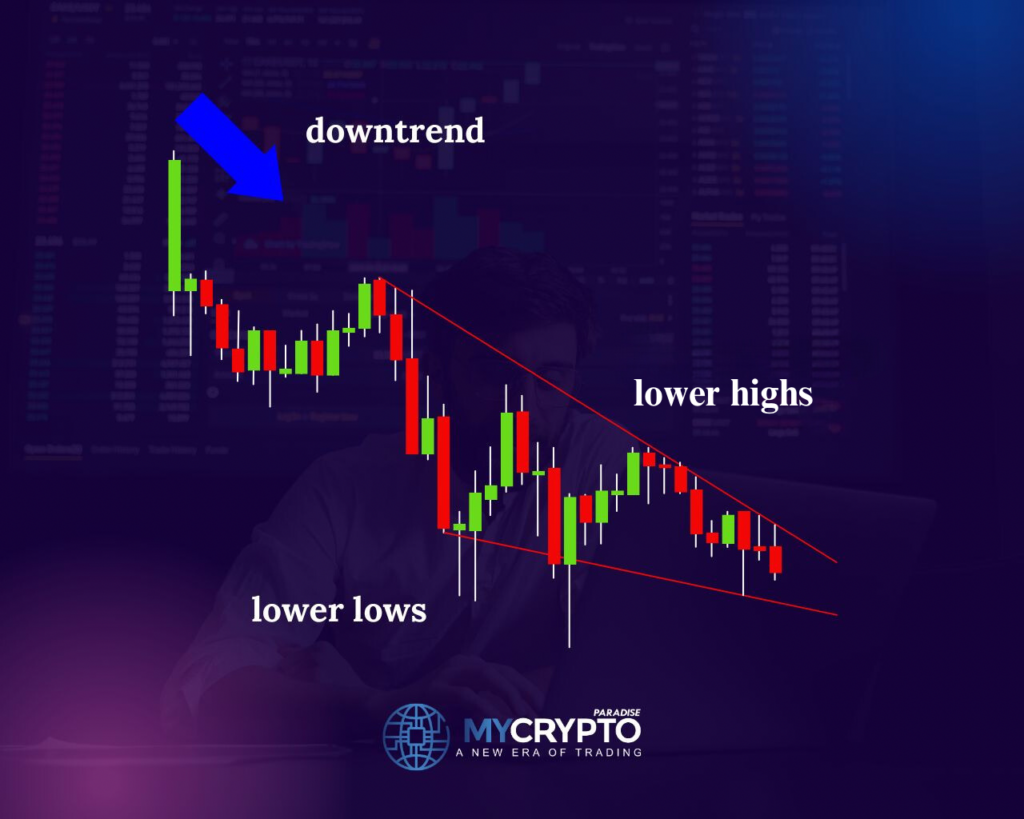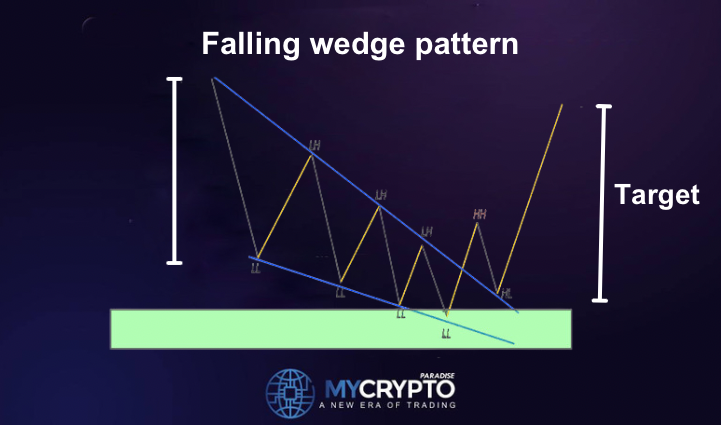Technical analysis is an important tool for traders who want to make informed decisions trading crypto. One of the most popular chart patterns used in technical analysis is the falling wedge pattern. In this article, we will explore what the falling wedge pattern is, how it works, and how traders can use it to make better trading decisions.
What is a Falling Wedge Pattern?
A falling wedge pattern is a bullish reversal pattern that forms when the price of an asset is moving lower within a narrowing range. The pattern is characterized by two downward sloping trend lines, with the lower trend line being steeper than the upper trend line. The pattern is considered bullish because as the price continues to move lower within the wedge, the trading range becomes narrower, indicating that the selling pressure is weakening. Eventually, the price will break out of the wedge pattern to the upside, indicating that the bulls have taken control of the market.
How Does a Falling Wedge Pattern Work?

A falling wedge pattern works by creating a narrowing trading range as the price of an asset continues to move lower. The pattern is formed by two downward sloping trend lines, with the lower trend line being steeper than the upper trend line. The steeper lower trend line indicates that the selling pressure is stronger than the buying pressure, causing the price to move lower.
As the price continues to move lower within the wedge pattern, the trading range becomes narrower, indicating that the selling pressure is weakening. At some point, the buyers will step in and start buying the asset, causing the price to move higher. Once the price breaks out of the wedge pattern to the upside, it is a strong signal that the bulls have taken control of the market and that the asset is likely to continue moving higher.
How to Identify a Falling Wedge Pattern
To identify a falling wedge pattern, professional crypto traders need to look for two downward sloping trend lines that converge at a point in the future. The lower trend line should be steeper than the upper trend line, and the pattern should be preceded by a downtrend.
Traders can use technical indicators like the Relative Strength Index (RSI) or the Moving Average Convergence Divergence (MACD) to confirm the pattern. When the RSI or MACD starts to move higher, it is a signal that the buying pressure is increasing and that the asset is likely to break out of the wedge pattern to the upside.
As you proceed with this crypto trading strategy tips, join our ParadiseFamilyVIPs using PRO20% for your special 20% discount. You will have exclusive access to the best crypto trading signals on Telegram provided by our team of professional traders. Contact us here to support you in navigating the exhausting world of crypto trading with confidence and comfort.
Crypto Trading Tips: Proper Use of Falling Wedge Pattern
Traders can use the falling wedge pattern to make better trading decisions. Here are a few tips on how to trade the pattern:
1. Wait for the Breakout: Traders should wait for the price to break out of the wedge pattern before entering a trade. The breakout should be confirmed by high trading volume and a move above the upper trend line.
2. Set Stop Loss Orders: Traders should set stop loss orders to limit their losses in case the price moves lower after the breakout. The stop loss order should be placed below the lower trend line of the wedge pattern.
3. Target the Price: Traders should target the price based on the height of the wedge pattern. They can calculate the target price by measuring the distance between the upper and lower trend lines at the widest point of the wedge and adding it to the breakout point.
4. Use Technical Indicators: Traders can use technical indicators like the RSI or MACD to confirm the breakout and to identify potential entry and exit points.
How to Properly Set Profit Target and Stop Loss While Trading with a Falling Wedge

Setting a profit target when using the falling wedge pattern can be done by measuring the height of the wedge pattern and projecting that distance from the breakout point. This gives traders an idea of the potential price move that could occur after the breakout.
To calculate the profit target, traders should measure the distance between the upper and lower trend lines at the widest point of the wedge and add it to the breakout point. The breakout point is the point where the price breaks out of the wedge pattern and closes above the upper trend line. This is typically the point where traders will enter a long (buy) position.
For example, if the distance between the upper and lower trend lines at the widest point of the wedge is $10 and the breakout point is $100, the profit target would be $110.
It is important to note that the profit target is a potential price move and not a guaranteed outcome. Traders should also consider market conditions and other technical indicators when setting their profit targets. They may choose to take partial profits as the price moves towards the target or adjust the target based on new information.
Traders should also use risk management tools such as stop loss orders to protect their profits. They may choose to move the stop loss order to break even once the price has moved in their favor or trail the stop loss order behind the price as it moves higher to lock in profits.
To set a stop loss order when using the falling wedge pattern, traders should place the order below the lower trend line of the wedge pattern. The stop loss order should be placed far enough away from the lower trend line to allow for some price fluctuations, but close enough to limit potential losses.
For example, if the lower trend line of the falling wedge pattern is at $100 and the trader wants to place a stop loss order, they may choose to place the order at $95. This allows for some price fluctuations, but still limits potential losses to $5 per unit.
Traders should also consider the size of their position when setting a stop loss order. A larger position may require a wider stop loss order to allow for greater price fluctuations, while a smaller position may require a tighter stop loss order.
It is important to note that even with a stop loss order in place, losses can still occur if the price moves quickly and the order is not filled at the specified price. Therefore, it is important for traders to monitor their positions closely and adjust their stop loss orders as needed to ensure effective risk management.
Limitations of the Falling Wedge Pattern
Like any technical analysis tool, the falling wedge pattern has its limitations. Here are a few limitations to keep in mind:
1. False Breakouts: Sometimes, the price will break out of the wedge pattern only to reverse and move lower. Traders should be prepared for this possibility and use stop loss orders to limit their losses.
2. Market Volatility: The falling wedge pattern may not work well in highly volatile markets, where the price can move erratically and unpredictably.
3. Timeframe: The falling wedge pattern may not work well on shorter timeframes, where the price movements are more erratic and less predictable.
MyCryptoParadise gives free updates and analyses on trending coins like BTC and ETH. We also share secret insights and free market updates on our telegram channels. Join them below:
Conclusion
The falling wedge pattern is a popular bullish reversal pattern that can be used by traders to make better trading decisions. The pattern is formed by two downward sloping trend lines that converge at a point in the future. The lower trend line is steeper than the upper trend line, indicating that the selling pressure is stronger than the buying pressure.
As the price continues to move lower within the wedge pattern, the trading range becomes narrower, indicating that the selling pressure is weakening. Eventually, the price will break out of the wedge pattern to the upside, indicating that the bulls have taken control of the market.
Traders can use the falling wedge pattern to make better trading decisions by waiting for the breakout, setting stop loss orders, targeting the price, and using technical indicators to confirm the pattern. However, traders should also be aware of the limitations of the pattern, including false breakouts, market volatility, and the timeframe. By keeping these limitations in mind, traders canuse the falling wedge pattern effectively to make informed trading decisions.





